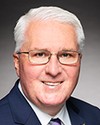Madam Speaker, I will be sharing my time with the member for Brampton East.
The emergence of fentanyl and its analogues, an opioid at least 100 times more potent than morphine, has given rise to a public health crisis in Canada that requires urgent action.
Bill C-37 proposes to amend the Controlled Drugs and Substances Act in a number of ways to address this crisis. In terms of harm reduction, it proposes to simplify the process of applying both for a supervised consumption site and for the exemptions that would allow certain activities to take place at a supervised site. I am pleased to see an evidence-based health-centric focus on harm reduction return to our health policy and legislation.
With regard to law enforcement and border security, among many changes, it would prohibit the importation of designated devices, unless they are registered with the Minister of Health. This would specifically prohibit unregistered importation of pill presses and encapsulators. It would expand the offence of possession, production, sale, or importation of anything with the knowledge that it will be used to produce or traffic in methamphetamines.
The bill would authorize the minister to temporarily add to a schedule substances that the minister has reasonable grounds to believe pose a significant risk to public health and safety. It would modernize inspection powers allowing border officers to open mail weighing 30 grams or less in order to stop drugs like fentanyl from entering Canada illegally through the mail system.
I would like to add my support for this bill and the proposed amendments to the CDSA. I would frame my support with particular reference to the recommendations from the December 2016 report by the House of Commons Standing Committee on Health, entitled “Report and Recommendations on the Opioid Crisis in Canada”. I am pleased to be a member of the standing committee.
My following remarks draw heavily on this report and the excellent summation of the witnesses' testimony and the committee's deliberations, as provided by the committee's members and supporting staff. The members of the standing committee agreed to undertake an emergency study of the opioid crisis in Canada. During the course of its study, the committee held five meetings, where it heard from a range of stakeholders, including federal and provincial government representatives, health care professionals, addiction experts, emergency front-line responders, representatives of first nations communities, and individuals with lived experience in substance abuse and addiction.
These witnesses outlined specific ways to address the opioid crisis and implored the committee to make recommendations that would lead to concrete action. I cannot emphasize enough the powerful, emotional, and compelling testimony that we heard from all witnesses urging the government to take action on this crisis.
The committee heard from witnesses that this situation began reaching crisis proportions in July 2013, when fentanyl, a prescription opioid 100 times more potent than morphine, became increasingly available on the illicit drug market. The assistant commissioner for federal policing special services with the Royal Canadian Mounted Police advised the committee that, because of the high demand for this drug, organized crime groups began importing illegal fentanyl from China. These are then transformed into tablet forms in clandestine labs in Canada using pill presses and are disguised as legal prescriptions, such as OxyContin, or are used in powder form as cutting agents for other illicit drugs.
The unknown potency of illegal fentanyl and other synthetic opioids, coupled with the fact that users are often unaware that they are taking the drug, has resulted in a dramatic increase in drug deaths in Canada. British Columbia has become the epicentre of the crisis because of its maritime ports and relative proximity to China.
According to the chief coroner for British Columbia, the percentage of drug deaths involving fentanyl increased from 5% in 2012 to 60% in 2016, with the involvement of fentanyl doubling the rates of drug deaths in the province. According to the coroner, the province had experienced—and this at the date of the testimony—488 illicit drug deaths at the end of August 2016, or approximately 61 deaths a month.
In addition—and again, I am drawing from the text of the committee's report—the committee heard that the RCMP is collaborating with law enforcement agencies in China to combat international drug trafficking networks, as well as to gain support for regulatory control of fentanyl analogues to prevent their distribution in Canada.
In terms of federal efforts at the border, the committee heard that Canada Border Services Agency is using innovative technologies and dogs to detect fentanyl at borders and maritime ports, resulting in more than 115 seizures since 2010.
However, the vice-president of the operations branch of the CBSA explained to the committee that the agency faces challenges detecting and intercepting fentanyl sent through the postal system. Fentanyl powder and equivalent substances are most often smuggled into Canada through the postal stream. Due to the increased volume of packages sent through postal and courier services, it can be a challenge for the CBSA to identify and intercept all shipments of concern. Postal and courier shipments are often accompanied by false declarations or are intentionally mislabelled. The RCMP further elaborated that these shipments are disguised or labelled in a variety of ways, such as printer ink, toys, and DVDs. To address this issue, Canada Border Services was reviewing the Customs Act to see if it could remove the restrictions on the agency's ability to open packages weighing less than 30 grams.
With respect to harm reduction strategies, the committee heard that supervised consumption sites are an evidence-based harm reduction measure. A number of witnesses expressed the opinion that changes to the CDSA, introduced in 2015, through Bill C-2, were a barrier to establishing new supervised consumption sites across the country and should be repealed or significantly amended.
After much deliberation, the committee made a number of recommendations.
Specific to harm reduction measures is recommendation number eight: “That the Government of Canada repeal or significantly amend the Controlled Drugs and Substances Act where it creates barriers to communities in establishing supervised consumption sites...”. Bill C-37 addresses this recommendation specifically.
Specific to law enforcement and border security, the committee made the following recommendations:
Recommendation 33 says:
That the Government of Canada take measures to grant authority and lawful privilege to Canada Border Services Agency officials to search and/or test suspect packages that weigh under 30 grams.
Recommendation 34 says:
That the Government of Canada develop a federal enforcement and interdiction strategy around the importation of illicit opioids.
Recommendation 35 says:
That the Government of Canada adopt measures to regulate commercial pill presses to limit their possession to pharmacists and others who hold an appropriate licence.
Recommendation 36 says:
That stronger criminal penalties for having a production machine be established.
Finally, recommendation 37 says:
That the Government of Canada provide more resources for drug testing packages and other shipments.
I am pleased to see that Bill C-37 addresses these recommendations and is consistent with the cited findings of the committee.
Looking beyond Bill C-37 and the amendments to the Controlled Drugs and Substances Act, the committee heard that this crisis should be considered a public health crisis, and the committee produced many other recommendations related to harm reduction, addictions prevention including prescribing practices and public education, addictions treatment, the need for mental health supports, and issues unique to first nations.
The Minister of Health has already responded to this crisis through a five-point action plan that includes better informing Canadians about the risks of opioids, supporting better prescribing practices, reducing easy access to unnecessary opioids, supporting better treatment options for patients, improving the evidence base and improving data collection, and also by making naloxone available as an emergency treatment.
Progressive action was also initiated by the minister through a pan-Canadian opioid summit held in November 2016.
Further, the minister has responded to every request that the provinces have raised with the government, and she continues to work with the provinces.
Finally, while this public health crisis must be addressed through the measures proposed in Bill C-37, and while as Canadians we battle the addictions brought on by opioid usage, it is important to remember that some Canadians, like Christina in my riding of Oakville, suffer from unrelenting and incurable pain. My thoughts are with her today. We must always ensure that their needs are addressed and that appropriate pharmaceutical care remains available to them.
I want the residents of my riding of Oakville to be protected from the opioid crisis and illicit fentanyl distribution. I will be supporting Bill C-37, and I encourage all members of the House to support this bill and to work to address this terrible public health crisis. Let us get this bill through the House and the other place as quickly as we can to help these Canadians.










